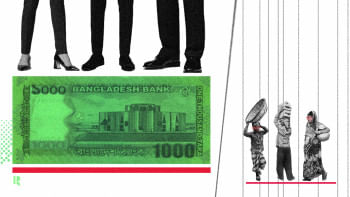A global state of disunion

The state of global order is less union, but more disunion or polarisation. One indicator is the price of gold rising over $2,222 per ounce, an all-time high. A higher gold price means a weaker dollar in real terms.
At the same time, the Dow, S&P500 and Nasdaq stock market indicators also touched record highs, following hints from Fed Chairman Jerome Powell that Fed interest rates may be peaking with possible cuts later this year.
On that note, the US certainly feels it never had it so good. The total market cap of US stocks increased by $10.2 trillion in 2023. Arising from the artificial intelligence (AI) boom, Nvidia alone added $1 trillion to its investors' wealth since last year.
In the fourth quarter of 2023, the US economy grew at an above-trend pace of 3.2 percent per year. In contrast, the January 2024 World Bank forecast indicated the slowest global growth pace in the last 30 years. In other words, the biggest economy in the world is growing faster than the rest of the world, but that is being sustained by growing fiscal and trade deficits, with its net debt to the world at $18 trillion. While the US is being able to sustain growth through more debt "opium" in MAGA—Make America Great Again—the rest of the world is languishing.
Given that both US presidential candidates are likely to continue the spending and debt spree in the next four years, will the rest of the world continue to fund its largest debtor?
In the short run, there is no alternative to putting money in the US dollar.
The European economy is hobbled by the impending disaster in Ukraine, where Russian forces seem to have taken the initiative due to superiority in arms supply and manpower. Since Nato and especially the US cannot afford to lose the Ukraine proxy war, we can expect the conflict to become entrenched, until exhaustion causes one side to collapse and call for truce. Even if Trump wins and may want to negotiate a ceasefire with Russia over Ukraine, the damage between Nato and Russia is so deep that Ukraine or whatever remains will be a drag on European recovery for decades to come.
This side of the Pacific will not see any easing of tensions between the US and China. China will take at least two to three years to deal structurally with its real estate debacle. The Japanese economy will try to normalise interest rates so that real income for the ageing Japanese workers may recover after years of stagnant nominal wages and a declining yen. And if oil prices continue to remain flat at around current prices, the Middle East oil producers will not have additional export income or savings, since they need to invest in changing the job structure away from the oil and gas industries. In the medium term, expecting the US to remain the sole engine of global recovery is not realistic.
The key issue in the global rivalry for leadership is not just about military or financial power, but about the technological edge and its ability to continue to generate wealth. A recent Australian Strategic Policy Institute (ASPI) study claimed that "China's global lead extends to 37 out of 44 technologies that ASPI is now tracking, covering a range of crucial technology fields spanning defence, space, robotics, energy, the environment, biotechnology, artificial intelligence (AI), advanced materials and key quantum technology areas." But as one shrewd East Asia Forum observer noted, "While China contributed 27.5 per cent to total global R&D expenditures in 2022 against the United States' 35.6 per cent, US technology giants still dominate research and innovation in critical technologies such as artificial intelligence." Chinese tech so far has not been monetised through stock market wealth like the US tech giants.
Many Chinese businessmen concede that the US leads in high tech, whereas they are much better on mid-tech, namely the ability to convert technology into production prowess. The US has superior cutting edge technology in many fields that have military usage, but as the Ukraine war has shown, the production of basic artillery shells still matters.
The global contest, therefore, hinges on who can convert AI technology into overall productivity across the broad economic front. It is widely accepted that the US is in the lead with China a lagging number two, and the rest still struggling on how to apply AI into day-to-day consumption, production, and distribution functions. Developing and poor countries that fail to upgrade their productivity through AI and knowledge-based innovation will remain in the low-tech category.
In other words, the world is in disunion not just from wealth and income disparities, but through the widening digital and knowledge application gaps. This includes the ability to apply the best knowledge to solve climate warming threats.
The US-China technology race is part of a long march of hegemonic proportions. But as history is shaped by multiple structural forces and random events, the ultimate winner in the 21st century may be neither of the two frontrunners, but one not even in the current radar screen. In this pluriverse of many possibilities, those that work hardest to innovate with new technology may be the real survivors.
Andrew Sheng is a distinguished fellow of Asia Global Institute at University of Hong Kong, and chief adviser to the China Banking Regulatory Commission.
Views expressed in this article are the author's own.
Follow The Daily Star Opinion on Facebook for the latest opinions, commentaries and analyses by experts and professionals. To contribute your article or letter to The Daily Star Opinion, see our guidelines for submission.

 For all latest news, follow The Daily Star's Google News channel.
For all latest news, follow The Daily Star's Google News channel. 











Comments